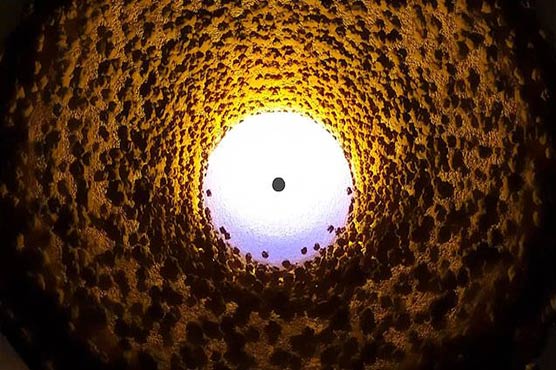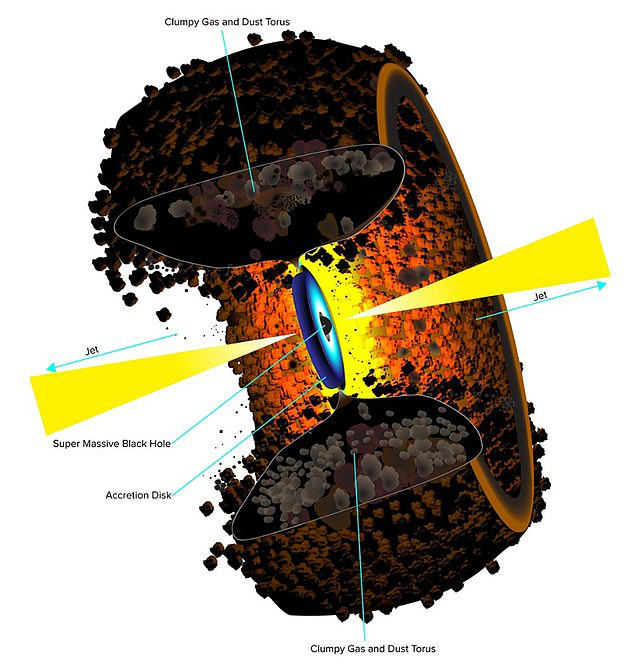First-ever image of dusty 'torus' ring around black hole captured

Cygnus A is one of the brightest radio sources in the sky and was imaged by VLA
(Web Desk) – Astronomers have just managed to take the first-ever direct image of a dusty doughnut swirling around a very active supermassive black hole.
The ring – known as a torus – was imaged around the black hole at the centre of Cygnus A, one of the most powerful radio galaxies in the Universe.
Cygnus A is approximately 800 million light-years away and is one of the brightest radio sources in the sky. The black hole at the centre of this galaxy has a mass of approximately the same as 2.5 billion suns. Imagery of the ultra-bright emissions came courtesy of the astronomers using the Very Large Array (VLA) telescope.
Some galaxies - aptly called radio galaxies - contain highly active supermassive black holes that are particularly bright in radio wavelengths. Such a black hole is surrounded by a disc of matter falling into it, and around that disc is a giant doughnut-shaped torus of dust.
Direct images were impossible until now due to the incredible gravity of black holes sucking in everything - even light.
The torus structure scientists have managed to capture is within the radio galaxy Cygnus A. Although Cygnus A is around 760-800 million light-years away, it is one of the brightest radio sources in the sky.
At its centre is a supermassive black hole equivalent to the mass of around 2.5 billion Suns, actively accreting tremendous amounts of matter and shooting relativistic jets of plasma light-years into space from its poles.

These features - the supermassive black hole, the accretion disc, the relativistic jets - combine to form a sort of "unified model" of the active galactic nucleus (AGN). Such nuclei can look radically different depending on the type of galaxy they’re in. Quasars, blazars, radio galaxies and Seyfert galaxies all have extremely bright AGNs, but they have different properties.
These differences could be explained by a dusty torus that obscures some features of the AGN depending on our viewing angle of the system.
"The torus is an essential part of the AGN phenomenon, and evidence exists for such structures in nearby AGN of lower luminosity, but we’ve never before directly seen one in such a brightly-emitting radio galaxy," said astrophysicist Chris Carilli of the National Radio Astronomy Observatory (NRAO).
"The torus helps explain why objects known by different names actually are the same thing, just observed from a different perspective."
Cygnus A’s AGN is, from our perspective, side-on, so that the torus obscures the black hole. The galaxy is also about 10 times closer than any galaxy of comparable radio brightness - so the NRAO team turned the Very Large Array (VLA) radio interferometer to trying to get a closer look at that theorised torus.

And they got it. Those observations revealed a torus of gas around 900 light-years across. That gas is distributed in clumps, circling the supermassive black hole at the heart of Cygnus A.
Cygnus A’s core is pretty whack, actually. In 2016, a second supermassive black hole was discovered not far from the centre - evidence that, sometime in its not-too-cosmically-distant past, the galaxy collided with another one. The other supermassive black hole sparked to life once it grew close enough to material to become active.
Will the two supermassive black holes merge one day? It’s possible - supermassive black holes can get pretty, well, super massive, perhaps even as much as 66 billion solar masses.

Cygnus A was also the subject of a study last year that found the torus is bound by magnetic fields that keep it in place.
Further observations could reveal even more details about the dynamics of the torus, and the role it plays in the AGN system.
"It’s really great to finally see direct evidence of something that we’ve long presumed should be there," Carilli said.
"To more accurately determine the shape and composition of this torus, we need to do further observing. For example, the Atacama Large Millimeter/submillimeter Array (ALMA) can observe at the wavelengths that will directly reveal the dust."
Later this week, we may be seeing our very first photographs of a black hole’s event horizon.
What is a black hole?
Black holes are so dense and their gravitational pull is so strong that no form of radiation can escape them - not even light.
They act as intense sources of gravity which hoover up dust and gas around them.
Their intense gravitational pull is thought to be what stars in galaxies orbit around.
How they are formed is still poorly understood.
Astronomers believe they may form when a large cloud of gas up to 100,000 times bigger than the sun, collapses into a black hole.
Many of these black hole seeds then merge to form much larger supermassive black holes, which are found at the centre of every known massive galaxy.
Alternatively, a supermassive black hole seed could come from a giant star, about 100 times the sun’s mass, that ultimately forms into a black hole after it runs out of fuel and collapses.
When these giant stars die, they also go ‘supernova’, a huge explosion that expels the matter from the outer layers of the star into deep space.
The research has been published in The Astrophysical Journal Letters.


